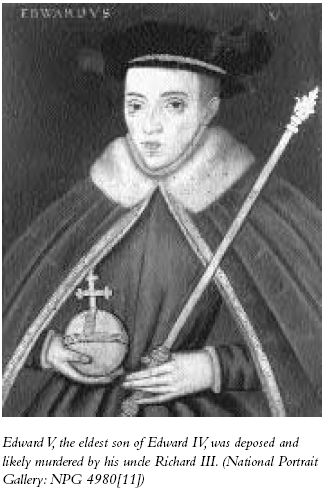- Edward V, King of England
- (1470–c. 1483)The eldest son of EDWARD IV and second monarch of the house of YORK, Edward V was the uncrowned king of England from April to June 1483, when he was dethroned by his uncle RICHARD III in an act of usurpation that reignited the WARS OF THE ROSES (see Usurpation of 1483).At Edward’s birth in November 1470, his family’s cause was in disarray. In the previous month, his father had been overthrown and forced into exile in BURGUNDY by a former ally, Richard NEVILLE, earl of Warwick, who restored HENRY VI to the throne (see Edward IV, Overthrow of; Readeption).Edward was born at Westminster, where his mother, Queen Elizabeth WOODVILLE, had taken SANCTUARY after her husband’s flight. However, by May 1471, Edward was heir to a Yorkist throne made secure by his father’s destruction of the rival house of LANCASTER and by his own birth (see Edward IV, Restoration of).In 1473, the three-year-old prince was given his own household at Ludlow, a Yorkist stronghold in Shropshire. Supervised by his maternal uncle Anthony WOODVILLE, Earl Rivers, the household included twenty-five councilors, a large staff of servants, and numerous schoolfellows and playmates drawn from the sons of English noblemen. Directed by Bishop John Alcock of Worcester, the prince’s formal educational program involved training in Latin,music, religion, and archery and other physical recreations. The prince was eventually made the nominal head of a Council of Wales, which included Rivers, Alcock, and other experienced royal administrators, and which was charged with maintaining order on the chronically disordered Welsh border.After his father’s death on 9 April 1483, the prince, now recognized as Edward V, was escorted to LONDON by Rivers. In late April, Richard, duke of Gloucester, Edward’s paternal uncle, intercepted the royal party at Stony Stratford, arrested Rivers, and took custody of the king. Over the next two months, Gloucester, fearing the young king was dominated by his mother’s family and unsure of his own future in a Woodville-controlled monarchy, had Edward V declared illegitimate and engineered his own usurpation of the throne, which was completed with his coronation as Richard III on 6 July. Edward V and his younger brother Richard PLANTAGENET, duke of York, were lodged together in the TOWER OF LONDON, where they disappeared from view by late summer. By the autumn of 1483, the country was awash with rumors that Richard III had murdered the princes.Although the exact fate of Edward V and his brother has never been resolved, and the role of Richard III in their disappearance is still vigorously debated, by September 1483 most people believed the princes were dead, and Richard’s responsibility for their fate was sufficiently accepted to undermine support for his regime. In the autumn of 1483, many Yorkists transferred their allegiance to Edward V’s elder sister, ELIZABETH OFYORK. When Henry Tudor, earl of Richmond (see Henry VII, King of England), the Lancastrian pretender to the throne, agreed to take Elizabeth as his queen, the Yorkist and Woodville interests supported BUCKINGHAM’S REBELLION as the first step in an eventually successful effort to win the Crown for Richmond. Thus, Edward V’s removal from the throne reopened the dynastic wars and ultimately destroyed the house of York.Further Reading: Fields, Bertram, Royal Blood: Richard III and the Mystery of the Princes (New York: Regan Books, 1998); Jenkins, Elizabeth, The Princes in the Tower (New York: Coward, McCann and Geoghegan, 1978); More, Sir Thomas, The History of King Richard III, edited by Richard S. Sylvester (New Haven,CT:Yale University Press, 1976); Pollard, A. J., Richard III and the Princes in the Tower (New York: St. Martin’s Press, 1991); Ross, Charles, Richard III (Berkeley: University of California Press, 1981);Weir, Alison, The Princes in the Tower (New York: Ballantine Books, 1992);Williamson, Audrey, The Mystery of the Princes (Chicago: Academy Chicago Publishers, 1986); the text of More’s History of King Richard III is also available on the Richard III Society Web site at http://www.r3.org/bookcase/more/moretext.html.

Encyclopedia of the Wars of the Roses. John A.Wagner. 2001.
